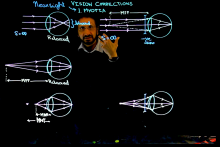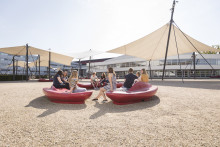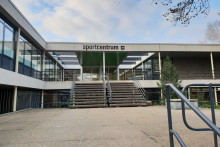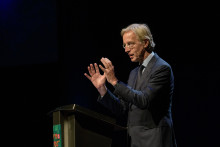Why did you create the lightboard?
Professor Manohar: ‘I teach Geometrical Optics course for first year Bachelor students Biomedical Technology. It’s a group of over 150 students who are fresh out of high school. We welcome them at the university in the middle of this bizarre year and I thought we should do more than just show them PowerPoint presentations with a little talking head in the corner. I wanted to give them a feeling that they are interacting with a real human being, and so I started looking for other teaching methods. I came across the idea of a lightboard. I did not want a commercial one for a start but wanted to set it up myself to also show to my students that you should be ready to build things if you need to solve problems. And lastly, the lightboard uses optical phenomena that the students are actually learning about in their course so in addition to being a vehicle to disseminate knowledge it is also a demo of these light effects.’
How does the lightboard work?
‘It’s pretty simple. It is essentially a pane of glass on which you write using neon markers. The glass is lined with light emitting diodes so that light is coupled into the glass pane. The light is confined to stay in the glass – thanks to the optical phenomenon called total internal reflection. When you write on the board, the light tries to leak out through the fluorescent ink and the markings glow. In order to see the teacher, the teacher also needs to be illuminated properly so we need some lighting on the user of the board. The video should be made in the dark to get a nice contrast with the letters, and so I record it all at night. The camera recording video and audio is on the other side of the glass pane, so after the video is done, you need to flip the movie frames so the students see the right orientation of the letters.’
You built the board by yourself, right?
‘Yes, I looked at some videos of making a lightboard and then made my own version of it. It is possible to purchase a professional setup, but I decided to make one myself. Our current situation will go on for some time and we will need to work from home. I didn’t want to rely on a recording studio located elsewhere. I want to make the videos whenever I need to. I bought the glass, the light emitting diodes and the frame from companies near the university.’
Do you use the lightboard only for one course?
‘Yes, but I plan to use it in more courses soon. I use it to make videos which support my lectures. It helps me to explain concepts I’d normally draw on the board in the classroom. I believe the student should be able to see your face, your eyes – to almost see you thinking. You need to show them how to get from one point to another, show them the thinking process including possible mistakes.’
How do students react to it?
‘They love it! One student told me that he felt as if he was getting a private lecture. They all seem to appreciate it and many of them were curious how it works.’
Do you think more teachers at the UT could and should use such a lightboard?
‘I presented it to some colleagues and they were really excited about it. But building a set at home might not be for everyone. They are quite bulky, require space and you need to make the room dark. It might be more practical if the UT arranged a commercial version that people could access on campus. There are of course other options, but I think all engineering courses would benefit from a lightboard. In those courses you intuitively reach for a pen and paper to explain your concepts. This would substitute that. I saw that Eindhoven University of Technology and Utrecht University both have commercial versions of this lightboard on campus. If that is the case, after we have decided that there would be enough users, we should think of setting one up here at the UT.’







